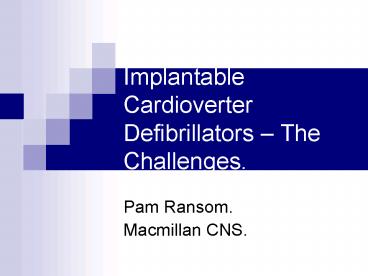Implantable Cardioverter Defibrillators The Challenges' - PowerPoint PPT Presentation
1 / 16
Title:
Implantable Cardioverter Defibrillators The Challenges'
Description:
Multidisciplinary plan/template of care for all at end stage of life. ... Version 11 of the LCP incorporated deactivating of ICD's' within goal 3. ... – PowerPoint PPT presentation
Number of Views:138
Avg rating:3.0/5.0
Title: Implantable Cardioverter Defibrillators The Challenges'
1
Implantable Cardioverter Defibrillators The
Challenges.
- Pam Ransom.
- Macmillan CNS.
2
- Why Me?
3
Liverpool Care Pathway.
- Multidisciplinary plan/template of care for all
at end stage of life. - Promotes patient-centred, collaborative care
utilising evidence-based guidelines. - Version 11 of the LCP incorporated deactivating
of ICDs within goal 3. - As with all goals of care supplementary
prompts/information education is the norm.
4
Local discussions highlighted.
- Lack of knowledge regarding ICDs within the
generalist field. - Lack of knowledge within the specialist
palliative care field also. - Limited information available for patients
regarding deactivation. - There appears to be disparity when discussing
deactivation within clinical practice.
5
Background to ICDs.
- An ICD is used to treat two types of rhythm
disturbance, ventricular tachycardia
ventricular fibrillation, by constantly
monitoring heart rhythm. If it senses either of
these abnormal rhythms, it delivers an electrical
impulse or shock to return the heart back to
normal. - An ICD can effectively prevent sudden cardiac
death.
6
(No Transcript)
7
Implantable Cardioverter Defibrillator.
- A mini-computer consisting of
- lt a pulse generator with batteries a capacitor
that can send a powerful shock to the heart. - lt an electronic logic circuit to tell the ICD
when to discharge. - lt lead electrodes placed in the heart (or rarely
, small electrodes placed under the skin) to
sense the cardiac rhythm deliver shock to the
heart muscle.
8
Issues at End of Life
- ICDs can prevent premature death from
arrhythmia but may also prolong the dying process
and make it more distressing.( Lynn,2005) - The shocks delivered can be painful thus are
inconsistent with comfort care.(Harrington,2004). - Patients with ICDs often suffer progressive
co-morbid cardiac conditions, many of who may
decline CPR. - Dying patients are at risk of receiving
inappropriate shocks in the terminal phase of
illness.
9
Indications for Deactivation.
- Continued use of an ICD is inconsistent with
patient goals. - Withdrawal of anti-arrhythmic medications.
- Imminent death- activation inappropriate in the
dying phase. - While an active DNR order is in force.
10
Disabling an ICD
- Treatment decisions involving ICD deactivation
are unavoidable. - Discussions may be initiated by patients their
carers or the Physician- stimulated by 1 of 3
possible concerns - 1) some patients will no longer value continued
survival. - 2) the ICD no longer offers the prospect of
increased survival. - 3) the ICD impedes active dying.
11
Time to discuss Deactivation
- Should planning for the eventual death be a
standard part of the consent process the
ongoing management for anyone accepting such a
device? - The need to discontinue use of the ICD is not an
occasional consideration it is a predictable part
of the course of dying for any patient with an
ICD who will die a natural death.
12
Discussing Deactivation
- Consult the ICD Physician.
- When discussing the expectations of turning off
the ICD the following should be made clear - lt the device will no longer provide life-saving
therapy in the event of a ventricular
tachyarrhythmia. - lt will not cause death.
- lt will not be painful, nor will its failure to
function cause pain. - Establish a plan of care ensuring availability to
address new questions. - If there are conflicts, consultation with the
palliative care team may be helpful.
13
Implications for practice.
- We need a mechanism / standard in place now for
when we become swamped! (if the number of
patients were to increase by 10 then our current
system would not work) - Is there a need to kwell the myths?
- Improved links between all health professionals
involved.
14
Work in Progress
- North Tyneside currently collaborating with the
Network to develop this standard. - Communication training continues to be delivered
across all health-professional groups. - Joint education/networking continues to expand.
- Recognising the dying phase and acknowledging
barriers preventing this are key to providing a
Good Death'. How well do we diagnose the dying
phase in this group of patients?
15
Key take home message..
- Good palliative care is an exercise in
anticipation. - Failure to plan ahead puts the patient/family in
a position of substantial unwarranted risk of
well-being. - Those of us who work downstream could be left
enduring the harms with patients/families those
upstream never realize the problems that they
cause.
16
Thankyou

